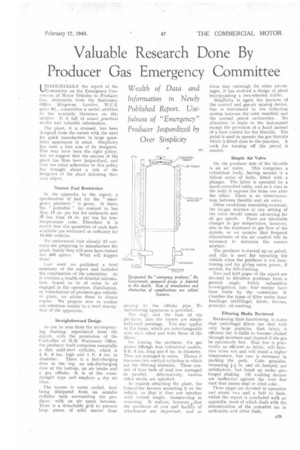Valuable Research Done By Producer Gas Emergency Committee
Page 39

If you've noticed an error in this article please click here to report it so we can fix it.
UNDOUBTEDLY the report of the Committee on the Emergency Conversion of Motor Vehicles to Producer Gas, obtainable from the Stationery Office, Kingsway, London, W.C.2, price 9d., constitutes a' useful addition to the available literature on this subject. It is full of sound practical advice and valuable information.
The plant, it is stressed, has been designed from the outset with the need for quick manufacture in large quantities uppermost in mind. Simplicity has been a first aim of its designers. This may have been the right policy, but we suggest that the success of the plant has thus been jeopardized, and that too strict adherence to this policy has brought about a risk of the designers of the plant defeating their own object.
Narrow Fuel Restriction
In the appendix to the report, a specification of fuel for the "emergency producer " is given. It limits the " potential " tar content to less than 15 oz. per ton for anthracite and tt less than 10 oz. per ton for lowtemperature coke. Elsewhere it is stated that the quantities of such fuels available are estimated as sufficient for 10,000 vehicles.
We understand that already 25 concerns are preparing to manufacture the plant. Surely they will soon have turned out 400 apiece. What will happen then?
Last week we published a brief summary of the report and included the constitution of the committee. As it contains a wealth of detailed information, bound to be of value to all engaged in the operation, distribution, or manufacture of producer-gas vehicles or plant, we advise these to obtain copies. We propose now to confine our attention mainly to a brief description of the apparatus.
Straightforward Design As can be seen from the accompanying drawing, reproduced from the report, with the permission of the Controller of H.M. Stationery Office, the producer itself comprises essentially a thin mild-steel cylinder, which is 4 ft. 6 ins, high and 1 ft. 6 ins, in diameter. There is a fuel-charging door at the top, an ash-discharging door at the bottom, an air intake and a gas offtake. It is of the crossdraught type and employs a dry air blast.
The tuyere is water cooled, heat being dissipated from an annular radiator tank surrounding the producer, with an air space between. There is a detachable grid to prevent large pieces of solid matter from passing to the off take pipe. No dee I i ke ring apparatus is provided.
The top, and the base of the producer, also the tuyere are simple mild-steel pressings. This also applies to the doors, which are interchangeable with each other and with those of the filters.
On leaving the producer, the gas passes thtough four cylindrical coolers, 3 ft. 6 ins, long and 6 ins. in diameter. They are arranged in series. Thence it traverses two vertical cylinders in which are the filtering elements. These consist of four beds of sisal tow arranged in parallel. Alternatively, various other media are specified.
As regards attaching the plant, the Committee favours mounting it on the vehicle, so that it does not interfere with overall length, manceuvring or reversing. It realizes, however,,that the questions of cost and facility of attachment are important, and as these may outweigh the other advantages, it has evolved a design of plant incorporating a two-wheeled trailer.
Simplicityis again the keynote of the control and gas-air mixing device. Gas is introduced to the induction system between the inlet manifold and the normal petrol carburetter. No alteration is made to the last-named except the provision of a hand instead of a foot control for the throttle. The pedal is used to operate the gas throttle which is fitted close to the junction. A cock for turning off the petrol, is needed.
Simple Air Valve On the producer side of the throttle
is an air valve. This comprises a cylindrical body, having around it a helical series of holes, fitted with a plunger. The latter is operated by a hand-controlled 'cable, and as it rises in the body it exposes the holes one after the other. There is no interconnection between throttle and air valve.
Other conditions remaining constant, the air-gas mixture at any setting of the valve should remain unvarying for all gas speeds. There are inevitable changes in gas temperature, however, also in the resistance to gas flow of the system, so we surmise that frequent adjustments of the air control will be necessary to maintain the correct mixture.
The producer is started up on petrol, and this is used for operating the vehicle when the producer is not functioning and for giving extra power, if needed, for hill-climbing.
Two and half pages of the report are devoted to filtration problems from a general angle. Fairly exhaustive investigations into this' matter have been made by the committee. It classifies the types of filter under these headings: centrifugal, fabric, fibrous, granular, oil-washing.
Filtering Media Reviewed Reviewing their functioning, it states that centrifugal filters can deal with only large particles, that fabric is efficient but is liable to become choked through moisture and charred if the gas be excessively hot. Sisal tow is practically as efficient as fabric, will function when wet and will stand a higher temperature, but care is necessary in
packing .the pads. Coke granules, measuring FA in. and oil damped, are satisfactory, but break up under prolonged shaking. Oil washing devices are ineffective against the very fine dust that passes sisal or oiled coke.
Three pages are devoted to operation and about two and a half to fuels, whilst the report is concluded with an appendix, most of which deals with the determination of the potential tar in anthracite and other fuels.




























































